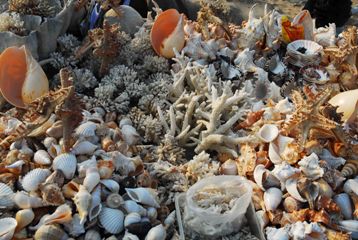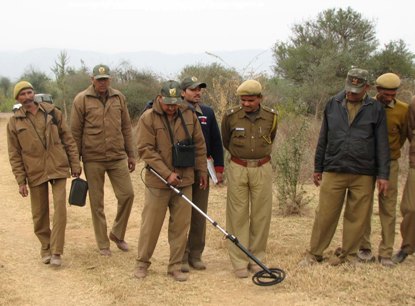On the occasion of World Environment Day, celebrated on 5th June every year, our Office is pleased to present an interview with Mr Samir Sinha, Head - TRAFFIC India, on the wildlife crime scenario in South Asia and its implications for the region.
South Asia: Fighting 'tooth and nail' to address wildlife crime in the region
 'Wildlife trade' refers to the commercial use by people of wild animal and plant resources. While most of this trade is legal, a significant portion of it is not. Over the years illegal wildlife trade has emerged as a form of transnational organised crime that is threatening the existence of many wild species across the globe.
'Wildlife trade' refers to the commercial use by people of wild animal and plant resources. While most of this trade is legal, a significant portion of it is not. Over the years illegal wildlife trade has emerged as a form of transnational organised crime that is threatening the existence of many wild species across the globe.
UNODC interviewed Mr Samir Sinha, Head - TRAFFIC India to understand the dimensions of this problem and the measures that are required to address this crime. TRAFFIC is an international wildlife trade monitoring network and a joint programme of the World Wildlife Fund (WWF), the global conservation organization and the International Union for Conservation of Nature (IUCN). Established in 1976, TRAFFIC works closely with National and State Governments and various agencies to help study, monitor and influence action to curb illegal wildlife trade and bring wildlife trade within sustainable levels.
1) Please explain what is wildlife crime and how does it impact society.
There are many elements of nature whose sustainable utilisation is critical to human livelihoods. For example, medicinal plants, marine harvests, food products of wild origin etc. Wild products are also used for fuel and fodder, as building material, to make clothing, handicrafts, ornaments etc. Eco - tourism is another important potential contributor to livelihoods. Regarding the ecosystem values of such natural elements, they play a key role in ensuring clean air and water, amongst other necessities and mitigating various environmental threats.
Illegal wildlife crime, by its very nature, destroys and removes - mostly unsustainably- these elements of natural wealth of a region that rightfully belong to its people, putting at stake their well being and livelihood opportunities for short term gain. It also has the potential to threaten social equity and sustainable inclusive growth. It also presents risks to human health and bio-security. It results in significant loss of revenue to governments while generating massive proceeds for criminals, which may include insurgent groups. Some of these ill gotten proceeds of crime can be directed against State institutions themselves, thus threatening the security of States and communities.
2) What are the main factors that drive wildlife crime?
The prime factors that drive wildlife crime include a burgeoning demand for natural products such as tiger parts (eg: claws, bones, skins, whiskers)
 and their derivatives, rhino horns, ivory, various medicinal plants, timber, reptile skins, birds, turtles and tortoises, marine products including shark derivatives, sea cucumbers etc across international borders, coupled with poor understanding of the elements of such crime amongst law enforcement agencies and the judiciary. Wildlife crimes are usually seen as crimes without a visible victim and not as something that affects society at large, thus receiving low priority and poor attention from enforcement agencies and society.
and their derivatives, rhino horns, ivory, various medicinal plants, timber, reptile skins, birds, turtles and tortoises, marine products including shark derivatives, sea cucumbers etc across international borders, coupled with poor understanding of the elements of such crime amongst law enforcement agencies and the judiciary. Wildlife crimes are usually seen as crimes without a visible victim and not as something that affects society at large, thus receiving low priority and poor attention from enforcement agencies and society.
Sometimes, the high economic incentives offered by such crimes coupled with the low probability of getting caught and the even lower probability of getting convicted, serves as an incentive for many to get involved in such crimes.
3) What have been the general trends of wildlife crime in South Asia? Have there been any recent changes in the trends?
During the past two decades, we have witnessed a sudden increase in the demand for wild animals and plants from

Perceived earlier as a local criminal activity, wildlife crime has today emerged from the shadows as a form of transnational organized crime, with organized criminal syndicates operating poaching and trade networks involving endangered species.
By its very nature, wildlife crime is dynamic in nature. The target species, methods of wildlife crime, concealment, transport, routes etc., all can be seen to change rapidly from time to time to keep a step ahead of law enforcement efforts. As a classic example, the illegal trade in Red Sanders wood has seen a dramatic shift in recent years, with earlier demand from Singapore and Japan being presently dominated by a huge demand from China. Many truckloads of this valuable timber have been intercepted while being transported across India from the states of Andhra Pradesh and a small part of Tamil Nadu - where the species is endemic - to Nepal, Myanmar and even directly to China across Ladakh! Several hundred tonnes of this wood have also been seized in Nepal in the last few years.
4) What are the existing policies and mechanisms to address wildlife crime at the international and regional level? How can these translate into results?
Most countries across the region have strict national laws to protect their wildlife resources and also a good system of nature reserves. Strong and well implemented national laws are the key to secure such resources systems. The Convention on International Trade in Endangered Species of Wild Fauna and Flora (CITES) remains the umbrella international agreement on trade in wild species of flora and fauna. Its aim is to ensure that international trade in specimens of wild animals and plants does not threaten their survival. All countries of South Asia except Maldives are signatories to the CITES Convention.
There is also a series of bilateral agreements - already in place or under development - amongst several countries in the region including India-Bangladesh, India-Bhutan, India-China,
 India-Nepal and Nepal-China that focus on collaboration to deal with wildlife crime.
India-Nepal and Nepal-China that focus on collaboration to deal with wildlife crime.
The Member States of the South Asian Association for Regional Cooperation (SAARC) recently adopted the SAARC Convention on Cooperation on Environment at Thimphu, Bhutan on 29th April, 2010. The scope of this Convention includes collaboration on wildlife conservation and combating illegal trade in wildlife and bio-resources.
The recent establishment of the South Asia Wildlife Enforcement Network (SAWEN) in January 2011 in Paro, Bhutan is a milestone in the region's efforts to address wildlife crime in the region. Led by member nations of Afghanistan, Bangladesh, Bhutan, India, Maldives, Nepal, Pakistan and Sri Lanka, the establishment of SAWEN has been facilitated by TRAFFIC, with support from agencies like the CITES Secretariat, UNODC, Interpol and the World Customs Organization and NGOs including WWF. The US Department of State has supported this initiative with a grant.
These collaborative efforts will certainly yield very good results in curbing wildlife crime as countries and agencies will be able to share information on such crimes and criminals in an effective manner. Also, this would strengthen common approaches to investigations and learning from each other's best practices. The support of organizations like UNODC, Interpol, the World Customs Organization and the CITES Secretariat would be crucial to the success of such efforts. Improving awareness of wildlife crime issues across the region would facilitate greater compliance and prevention of this crime.
5) Can you give examples of good practices which have helped to prevent these crimes?
Wherever agencies have collaborated and come together to share expertise and information, results
 have been there to see. There have been several instances where poachers have been arrested and wild products have been seized on the basis of shared information. NGOs like TRAFFIC and WWF have played a catalytic role to improve understanding of such issues amongst enforcement agencies and to strengthen their capacity to effectively respond to such challenges. We have been privileged to work with various agencies including Forest Departments, Police, Army, Paramilitary, Customs, Railways and the Central Bureau of Investigation etc. towards such efforts. Technical support has also been provided by agencies like the Wildlife Institute of India.
have been there to see. There have been several instances where poachers have been arrested and wild products have been seized on the basis of shared information. NGOs like TRAFFIC and WWF have played a catalytic role to improve understanding of such issues amongst enforcement agencies and to strengthen their capacity to effectively respond to such challenges. We have been privileged to work with various agencies including Forest Departments, Police, Army, Paramilitary, Customs, Railways and the Central Bureau of Investigation etc. towards such efforts. Technical support has also been provided by agencies like the Wildlife Institute of India.
Introduction of wildlife sniffer dogs, use of metal detectors to detect snares and traps and promoting the use of better forensic tools to deal with wildlife crimes, as has been pioneered by TRAFFIC in the region, have yielded very good results in prevention and investigation of these crimes.
6) What needs to be done further to strengthen wildlife law enforcement and prevent wildlife crime?
Constant collaboration, sharing of expertise and information as well as a joint effort across Government agencies

Click here to know more about TRAFFIC and TRAFFIC India
Click here to know more about the CITES Convention
Photo credits: TRAFFIC India